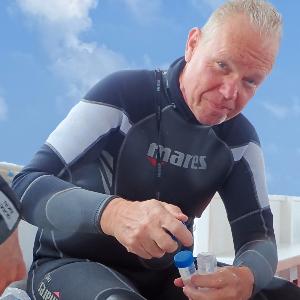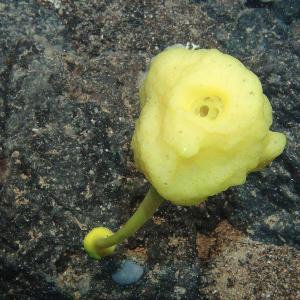Prof. Dr. Gert Wörheide
Professor und Inhaber des Lehrstuhles für Paläontologie und Geobiologie
Sprechstunde:
by appointment only

I am an evolutionary geobiologist specializing in the biodiversity, evolution, biomineralization, and responses to climate change of coral reef organisms, particularly sponges and corals. Since 2008, I hold the Chair for Paleontology & Geobiology at LMU Munich and am the Research Director of the Bavarian State Collections for Paleontology and Geology and the Paleontological Museum in Munich. I co-founded LMU's international Master's Program in "Geobiology & Paleobiology," served as Dean / Vice-Dean of LMU’s Faculty of Geosciences for a decade, and am an elected member of the Academia Europea and the Leibniz-Sozietät der Wissenschaften zu Berlin. I also serve as the Chair of the European Chapter of the International Coral Reef Society (ICRS) and have published over 200 articles in leading journals.

G. Wörheide in his favorite office - on a boat in the Maldives collecting samples. | © Gert Wörheide
Our research explores the interactions between the geo- and biosphere through time, integrating data from living organisms and the fossil record. We focus on the biodiversity and evolution of marine organisms and their symbionts, as well as the origins and evolution of biomineralization. Using approaches from molecular biology to genomics, we link modern data with paleontological evidence to better understand life’s origins, evolution, and functions across past, present, and future.

Image of a glass sponge taken during the R/V Sonne expedition SO254 which investigated sponge communities on the seafloor of the southwestern Pacific Ocean from sunlit zones down to the deep sea (~5 km water depth) | © GEOMAR
The evolutionary relationships among the main animal lineages (“phyla”) remain debated. Large-scale phylogenomic analyses of amino acid sequences have advanced our understanding but often conflict with traditional morphology-based or single-gene phylogenies. Key uncertainties concern the placement of non-bilaterian animals—sponges, placozoans, cnidarians, and ctenophores—and their relationships to bilaterians: Are sponges the earliest diverging lineage? Are placozoans or ctenophores more ancestral or derived? To address these questions, we apply phylogenomic approaches, including transcriptome and genome analyses as well as gene content and synteny comparisons. Full genome sequences of non-bilaterian animals not only clarify phylogenies but also reveal the early metazoan genomic toolkit that enabled their evolutionary success since the Precambrian.
Juravel, K., Porras, L., Höhna, S., Pisani, D., Wörheide, G., 2023. Exploring genome gene content and morphological analysis to test recalcitrant nodes in the animal phylogeny. PloS One 18 (3), e0282444.
Pett, W., Adamski, M., Adamska, M., Francis, W.R., Eitel, M., Pisani, D., Wörheide, G., 2019. The role of homology and orthology in the phylogenomic analysis of metazoan gene content. Molecular Biology and Evolution 36, 643–649.
Feuda, R., Dohrmann, M., Pett, W., Philippe, H., Rota-Stabelli, O., Lartillot, N., Wörheide, G., Pisani, D., 2017. Improved modelling of compositional heterogeneity supports sponges as sister to all other animals. Current Biology 27, 3864–3870.
Pisani, D., Pett, W., Dohrmann, M., Feuda, R., Rota-Stabelli, O., Philippe, H., Lartillot, N. & Wörheide, G., 2015. Genomic data do not support comb jellies as the sister group to all other animals. Proceedings of the National Academy of Sciences 112(50): 15402-15407.
Philippe, H., Brinkmann, H., Lavrov, D.V., Littlewood, D.T.J., Manuel, M., Wörheide, G., Baurain, D., 2011. Resolving difficult phylogenetic questions: why more sequences are not enough. PLoS Biology 9, e1000602.

Calcein-stained growing spicules in the calcareous sponge Sycon ciliatum. | © Oliver Voigt
Biomineralization is the process by which organisms form minerals under biological control. Skeletons of multicellular organisms are produced through biologically controlled mineralization, forming integral structures such as bones, shells, and teeth—often the only remains preserved in the fossil record. This highly regulated process generates materials of remarkable strength and beauty, including of commercial value, such as pearls. Our research investigates how organisms form calcareous skeletons and the genetic mechanisms underlying mineral deposition. We also explore the evolutionary diversification of calcareous biomineralization across Metazoa and assess the impacts of global change, particularly climate change and ocean acidification, on calcifying organisms using controlled mesocosm experiments.
Voigt, O., Wilde, M.V., Fröhlich, T., Fradusco, B., Vargas, S., Wörheide, G., 2025. Genetic parallels in biomineralization of the calcareous sponge Sycon ciliatum and stony corals. eLife 14, Rp106239.
Conci, N., Griesshaber, E., Rivera-Vicéns, R.E., Schmahl, W.W., Vargas, S., Wörheide, G., 2024. Molecular and mineral responses of corals grown under artificial Calcite Sea conditions. Geobiology 22 (1), e12586.
Conci, N., Lehmann, M., Vargas, S., Wörheide, G. 2020. Comparative proteomics of octocoral and scleractinian skeletomes and the evolution of coral calcification. Genome Biology and Evolution: evaa162.
González-Pech, R. A., Vargas, S., Francis, W. R., & Wörheide, G. 2017. Transcriptomic resilience of the Montipora digitata holobiont to low pH. Frontiers in Marine Science 4: 403.
Jackson, D. J., Macis, L., Reitner, J., Degnan, B. M., & Wörheide, G. 2007. Sponge Paleogenomics Reveals an Ancient Role for Carbonic Anhydrase in Skeletogenesis. Science 316(5833): 1893-1895.

Tips of the arms of the coral-eating crown-of-thorns seastar Acanthaster cf. solaris in Okinawa, Japan. | © Gert Wörheide
We use DNA and protein sequence data to reconstruct evolutionary relationships and processes. Our research focuses on marine sponges, placozoans, and echinoderms, addressing both ecological timescales (e.g., phylogeography of Indo-Pacific invertebrates) and deep evolutionary splits among early animals, e.g., sponges (Phylum Porifera). We are also strongly engaged in DNA barcoding, which applies short, species-specific DNA fragments for rapid species identification. Having pioneered sponge barcoding, we coordinate the international Sponge Barcoding Project and curate the Sponge GenTree Server, advancing global taxonomic and biodiversity research.
Erpenbeck, D., Deister, F., Ekins, M., Dotzler, N., Hooper, J.N.A., Samaai, T., Schätzle, S., van der Sprong, J., Vargas, S., Wörheide, G., 2025. Target-enriched multilocus assay on poriferan museum collections unsettles tethyid classification. Molecular Phylogenetics and Evolution 213, 108436.
Dohrmann, M., Reiswig, H.M., Kelly, M., Mills, S., Schätzle, S., Reverter, M., Niesse, N., Rohde, S., Schupp, P., Wörheide, G., 2023. Expanded sampling of New Zealand glass sponges (Porifera: Hexactinellida) provides new insights into biodiversity, chemodiversity, and phylogeny of the class. PeerJ 11, e15017.
Wörheide, G., Kaltenbacher, E., Cowan, Z.-L., Haszprunar, G., 2022. A new species of crown-of-thorns sea star, Acanthaster benziei sp. nov. (Valvatida: Acanthasteridae), from the Red Sea. Zootaxa 5209 (3), 379–393.
Eitel, M., Francis, W.R., Varoqueaux, F., Daraspe, J., Osigus, H.-J., Krebs, S., Vargas, S., Blum, H., Williams, G.A., Schierwater, B., Wörheide, G., 2018. Comparative genomics and the nature of placozoan species. PLoS Biology 16, e2005359.